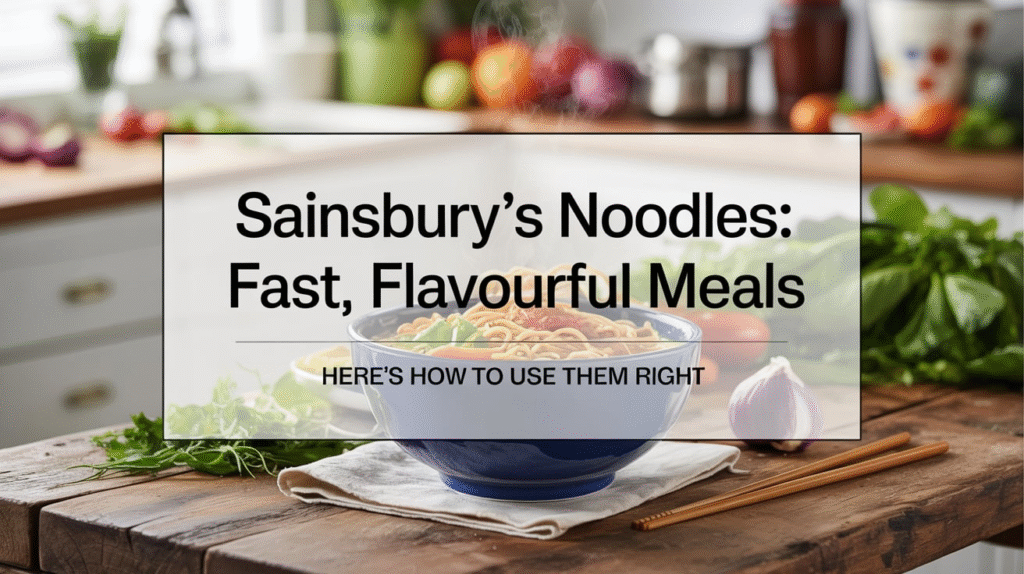Sainsbury’s Noodles offer an easy, budget-friendly base for creating a wide range of global dishes. From stir-fries to soups and noodle salads, they cook quickly and absorb flavour well, making them ideal for both beginners and experienced cooks. Available in varieties like egg noodles, rice noodles, wholewheat and instant options, Sainsbury’s noodle range caters to different dietary preferences and recipe needs.

Types of Sainsbury’s Noodles and How to Use Them
Each type of noodle has its own texture and flavour, best suited for specific styles of cooking. Choosing the right noodle helps achieve an authentic and satisfying dish.
Egg Noodles
These are among the most popular and versatile noodles in the UK.
- Medium egg noodles are great for stir-fries, chow mein, and broth-based soups.
- Fine egg noodles work well in spring rolls and light stir-fries with vegetables.
Rice Noodles
Gluten-free and naturally light, these noodles are common in Asian dishes.
- Ideal for Thai dishes like Pad Thai or Vietnamese pho.
- Best when soaked or boiled until just tender, then rinsed.
Wholewheat Noodles
For a fibre-rich alternative, Sainsbury’s offers wholewheat noodles.
- Nutty flavour pairs well with sesame or miso sauces.
- Holds up well in hearty noodle bowls with roasted vegetables.
Instant Noodles
Quick and convenient, these are perfect for fast lunches or late-night meals.
- Comes with flavour sachets for ease of use.
- Can be upgraded with fresh vegetables, eggs, or leftover meats.
Why Sainsbury’s Noodles Are a Reliable Choice
Sainsbury’s has developed a reputation for offering high-quality noodles at reasonable prices.
Consistent Quality and Variety
Their noodles are easy to prepare and retain good texture after cooking.
- No artificial colours or preservatives in most varieties.
- Different sizes and types available for soups, salads, and stir-fries.
Clear Packaging and Cooking Instructions
Each pack includes preparation instructions for best results.
- Cooking times are accurate and suitable for busy home kitchens.
- Ingredient lists help identify allergens and dietary suitability.
Cooking Tips for Perfect Sainsbury’s Noodles
To get the most out of your noodles, follow these simple cooking tips.
Don’t Overcook
Noodles become mushy if overcooked, especially rice and instant varieties.
- Cook just until tender, then drain and rinse with cold water.
- Stir-fry briefly in sauces to enhance flavour and prevent sogginess.
Toss in Oil After Boiling
This prevents clumping and adds a glossy finish.
- A small drizzle of sesame oil or neutral oil works well.
- Especially helpful when preparing noodle salads.
Easy Recipes to Try Using Sainsbury’s Noodles
Sainsbury’s noodles are perfect for quick meals with just a few pantry items.
Classic Stir-Fry
Combine noodles with vegetables, soy sauce, garlic, and ginger.
- Add protein like prawns, chicken, or tofu.
- Use a splash of hoisin or oyster sauce for added richness.
Soup Noodles
Use noodles as a base for warming soups and broths.
- Add chicken or beef stock, mushrooms, and spring onions.
- Top with a soft-boiled egg for extra depth.
Noodle Salads
Serve noodles cold with a light dressing for a refreshing meal.
- Use rice or egg noodles tossed with sesame oil, soy sauce, and vinegar.
- Add sliced cucumber, carrots, and crushed peanuts for crunch.
Spicy Peanut Noodles
A rich and satisfying vegetarian dish.
- Mix peanut butter, soy sauce, chilli flakes, and lime juice into a creamy sauce.
- Toss with noodles and steamed greens like pak choi or spinach.
How to Store and Reuse Cooked Noodles
Cooked noodles store well and can be repurposed for other meals.
Keep Refrigerated
Store in airtight containers for up to 3 days.
- Rinse with hot water before reheating to refresh texture.
- Avoid freezing unless part of a full dish like a soup or stir-fry.
Repurpose Leftovers
Leftover noodles can be quickly turned into new meals.
- Add to omelettes, frittatas, or even wraps.
- Stir into soups for a fast lunch solution.
FAQs
Here are some questions and answers about Sainsbury’s Noodles.
Are Sainsbury’s noodles suitable for vegetarians or vegans?
Yes, many of Sainsbury’s noodle options are vegetarian or vegan-friendly. Always check the label for specific ingredients and allergen information.
How do I stop noodles from sticking together?
Rinse noodles under cold water after boiling, then toss with a little oil. Stir occasionally during cooking if using in a stir-fry.
Can I cook Sainsbury’s noodles in a rice cooker?
Yes, but it depends on the model. Most rice cookers allow you to boil noodles using the ‘cook’ setting. Be sure to monitor to prevent overcooking.
What’s the best Sainsbury’s noodle type for Pad Thai?
Rice noodles are the best option for Pad Thai. Soak or boil them until soft, rinse, then stir-fry with tamarind, soy sauce, garlic, and your preferred protein.
Are Sainsbury’s instant noodles unhealthy?
Instant noodles can be high in sodium and low in fibre. You can improve their nutritional value by adding vegetables, eggs, or lean protein.
Sainsbury’s Noodles offer a quick and delicious way to enjoy a wide variety of meals, whether you’re preparing a weekday stir-fry or an indulgent noodle soup. With options for every diet and cooking style, they’re an essential pantry staple for versatile home cooking.
